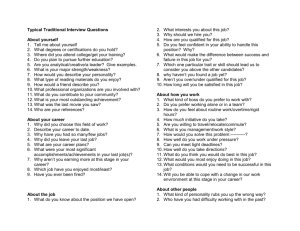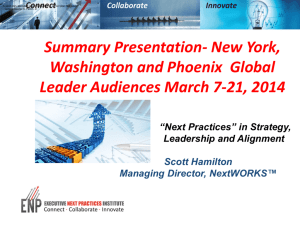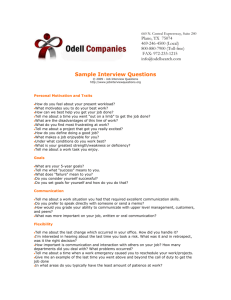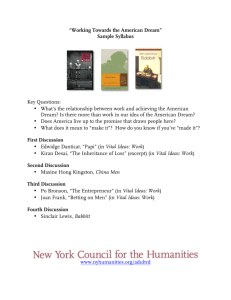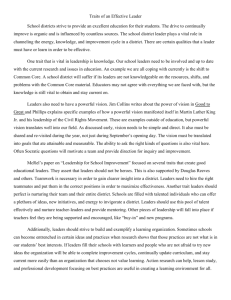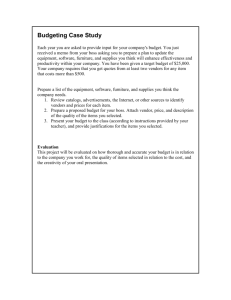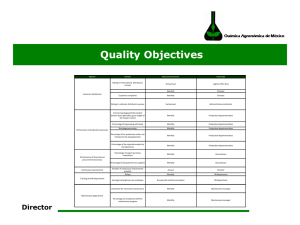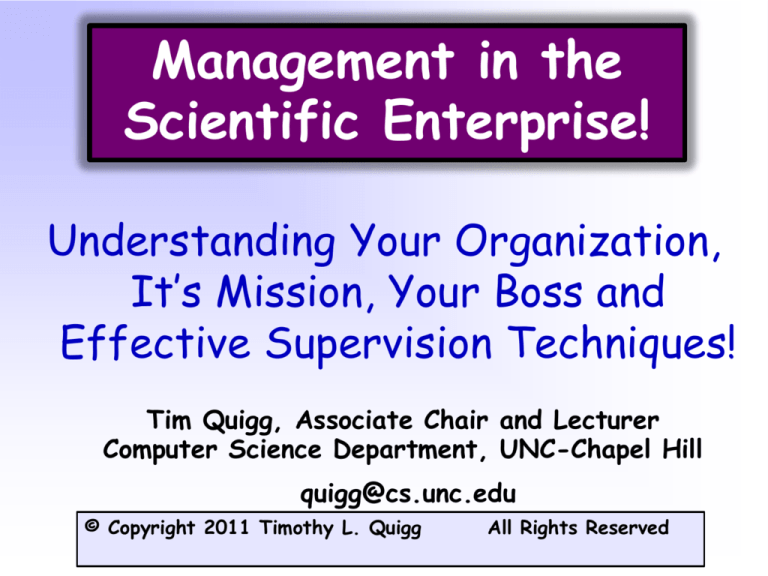
Management in the
Scientific Enterprise!
Understanding Your Organization,
It’s Mission, Your Boss and
Effective Supervision Techniques!
Tim Quigg, Associate Chair and Lecturer
Computer Science Department, UNC-Chapel Hill
quigg@cs.unc.edu
© Copyright 2011 Timothy L. Quigg
All Rights Reserved
While reflecting upon the difference
between business and academia,
Erskine Bowles, former President of
UNC once remarked:
“I came from a world of ready, fire
aim.
And I came to a world of ready, aim,
aim, aim, aim…”
And then, while he was a
Professor at Harvard, Henry
Kissinger once commented on
“academic politics”!
“Academic politics are so
vicious because the stakes
are so low.”
Worthy of consideration if you
plan an academic career! But
all organizations have their
issues so the real task is to
first understand how
organizations work and then
determine how you can be
successful within the
organization!
Three Keys to Being Successful
in Any Organization
Understand the structure of your organization
and how it influences decision-making
Understand the true “mission” of your
organization and understand your own
professional/personal goals. Seek ways to
optimize accomplishment of both!
Develop skills that will enhance your ability to
succeed in the organization (as both a
supervisor and as a subordinate)!
Understand the structure of
your organization and how it
influences decision-making
Three “Schools” of Organization
Theory
1. Hierarchical/Classical
2. Human Relations/Behavioral
3. Organic/Systems
1. Hierarchical/Classical
2. Human Relations/Behavioral
3. Organic/Systems
1.
Hierarchical/Classical School
Views organizations as Machines!
Draws its inspiration from Engineering
Focuses on:
• Lines of authority
• Specialization/expertise
• Division of Labor
• Rules and regulations
• Separation of line and staff
Frederick Taylor’s focus on job design efforts
(specialization) of scientific management and Max
Weber’s celebration of bureaucracy
Social structure is a pyramid (“serfs” at bottom
and “supreme commander” at top)
Assumptions:
• People located higher in organization are smarter
• They have better information; therefore, they
better know what’s going on in the organization
• Watching over people (preventing them from
making mistakes) is a primary task of
management!
Reality:
• People tend to say what they think the boss
wants to hear, thus distortions occur at every
level of reporting
• The greater the number of levels, the greater
the opportunity for factual distortions
• The higher you go in an organization the more
dissonance between perception and reality
• Therefore, higher level managers often make
decisions based upon completely fraudulent data!
2.
Human Relations/Behavioral
School
Views organizations as Groupings of People
Draws inspiration from Biological Science
Focuses on:
• Delegation of authority
• Employee autonomy
• Trust and openness
• Concerns for “whole person”
• Interpersonal dynamics
Chester Barnard’s Functions of the Executive
(1938) emphasizing organizations as cooperative
systems and role of leadership
People are connected, but often laterally and
certainly not in pyramids
No “alpha person” on top
Authority is distributed more evenly
Emphasis on dynamic, functional work groups
“Flat” organization structure
Works best with professional, scientific or
technical organizations
3.
Organic/Systems School
Views organizations as Independent
Entities/Organisms
Draws inspiration from Biological Science
and Systems Theory
Focuses on:
•
•
•
•
Inputs
Outputs
Transactions
Feedback
Guiding Principle: Organizations continually
strive for equilibrium. As they experience
new environmental stimuli, they seek to
adapt and find a new state of equilibrium
Special Case: Virtual
Organizations
Made possible through technology (computers,
high-speed communications, internet)
Decentralized and non-hierarchical
Often transitory
Often voluntary (e.g., Linux, Scientific
Collaborations)
Organized around common interests or problems
Special Case: Virtual
Organizations
So, which characteristics
do you see in your
organization?
What impact does the particular structure
of your organization have on:
•
•
•
How decisions are made?
How successful the organization is at
achieving its goals?
How satisfied you are working in the
organization?
Are some types of
organizations best suited
to a particular structure?
How about:
•
•
•
The military?
Large corporations?
Universities? Research-focused
organizations?
Aspects of all three
may exist simultaneously in research
organizations and universities.
Sometimes different levels of an organization
will be structured differently. Recognizing
the structure will help you understand
how to navigate your way
toward success!
Aspects of all three
may exist simultaneously in research
organizations and universities.
Sometimes different levels of an organization
will be structured differently. Recognizing
the structure will help you understand
how to navigate your way
toward success!
Remember, as a Manager you
will likely have considerable
influence over the structure
of “Your Shop” (Lab). You
don’t have to repeat the
mistakes you have experienced
learn from them!
Understand the true “mission” of
your organization and understand
your own professional/personal
goals. Seek ways to optimize
accomplishment of both!
Mission – the primary reason for
an organization’s existence! It’s
purpose!
But how does one know the true
mission of an organization?
• Check the budget – How are resources
allocated? When cuts are made, what
criteria are used?
• What metrics are used to evaluate
success?
• Who are the primary “clients”?
• Don’t just read the propaganda: ask,
listen and observe!
“Align your efforts to optimize
the accomplishment of both the
organization’s mission and your
own goals!”
To do so, you must first identify the
vital tasks that lead to mission/goal
accomplishment and then focus your
efforts on these vital tasks .
“Align your efforts to optimize
the accomplishment of both the
organization’s mission and your
own goals!”
To do so, you must first identify the
vital tasks that lead to mission/goal
accomplishment and then focus your
efforts on these vital tasks .
“Align your efforts to optimize
the accomplishment of both the
organization’s mission and your
own goals!”
Working hard doesn’t do any
good if you are working on the
wrong things!
Effective Time Management
To-Do lists are helpful, but they usually
don’t help in establishing priorities
Example: What would be your primary goal
as a young faculty member?
•
Getting tenure
What helps you get tenure?
•
•
•
Publications
Research (funding) – patents? In some cases!
Teaching
But You Don’t Want to Get
Tenure and then a Divorce!
Personal priorities
Spouse - family
Other important things that make
life worth living!
My Approach to Time Management
Definitions:
•
•
Imperative – has a deadline looming (time critical)
Vital – directly impacts your career/life
Four categories:
•
•
•
•
Imperative and vital – gotta do it and now!
Vital but not imperative – gotta do it, but it can wait
awhile
Imperative but not necessarily vital – hardest of all,
depends on the value you place on it
Not imperative and not immediately vital –can wait till
tomorrow! These are the “time killers”!
Task
Your grant
application
is due
today
Imperative Vital not Imperative
and Vital Imperative not Vital
Your
X
Grading
Papers/Exams
Your tenure
package is
due to chair
today
X
X
Not imperative
and not vital
Task
Imperative Vital not Imperative
and Vital Imperative not Vital
Hanging
Pictures in
Your
Office
Not imperative
and not vital
Your
X
Getting a
piece of
equipment
fixed you will
soon need
(but not
today)
Return a
call to your
spouse
about dinner
X
X
Task
Imperative Vital not Imperative
and Vital Imperative not Vital
Throwing
a party
for your
lab
Not imperative
and not vital
Your
Keeping up
with the
literature in
your field
Reviewing
the agenda
for next
month’s
department
retreat
X
X
X
Task
Your NIH
Program
Officer
needs a
revised
budget by
5:00 pm
Attending an
outreach
meeting for
taking science
to middle
school
students
Imperative Vital not Imperative
and Vital Imperative not Vital
Your
Review a
manuscript
for a journal
X
X
X
Not imperative
and not vital
Time Management
Remember to routinely reclassify
tasks:
As deadlines draw near, more
tasks become imperative!
Efficiency - Effectiveness
It’s A Balancing Act!
Efficiency – Producing the greatest quantity of
work for each unit of resource expended (or
producing a unit of work for the smallest possible
expenditure of resources)
Effectiveness – Successfully accomplishing the
goals/objectives of the organization.
Fulfilling Its Mission!
Perils of Over-Emphasizing
Efficiency
Can lead to the faulty belief that
efficiency leads to effectiveness
Sub-Unit Optimization - When every
sub-unit in an organization operates as
efficiently as possible, the overall
organization operates at peak
efficiency. Right?
Well, not always!
Sub-Unit Optimization
Sometimes one unit may need to operate
inefficiently in order to create an overall
organizational efficiency
Overemphasis on efficiency can take
emphasis off effectiveness (mission)
A perfectly efficient organization may
not accomplish it’s mission (therefore is
not an effective organization)
Develop skills that will enhance
your ability to succeed in the
organization (as both a supervisor
and as a subordinate)!
Yes, as a successful academic
scientist you will be a supervisor of
people and a manager of
resources:
like it or not!
“Poor management is more than a nuisance at the
edges of laboratory work. Scientists are human
beings first, and ineffective leadership will wreak
havoc. Labs will get thrown into turmoil,
personality conflicts will undermine teamwork,
discrimination will isolate group members, and the
creativity so essential to truly great work will
vanish, to say that leadership quality can make or
break a research-driven organization is not an
overstatement – it is the conclusion of scientists
themselves.”
Alice M. Sapienza
Managing Scientists: Leadership
Strategies in Scientific Research
“Poor management is more than a nuisance at the
edges of laboratory work. Scientists are human
beings first, and ineffective leadership will wreak
havoc. Labs will get thrown into turmoil,
personality conflicts will undermine teamwork,
discrimination will isolate group members, and the
creativity so essential to truly great work will
vanish, to say that leadership quality can make or
break a research-driven organization is not an
overstatement – it is the conclusion of scientists
themselves.”
Alice M. Sapienza
Managing Scientists: Leadership
Strategies in Scientific Research
“Poor management is more than a nuisance at the
edges of laboratory work. Scientists are human
beings first, and ineffective leadership will wreak
havoc. Labs will get thrown into turmoil,
personality conflicts will undermine teamwork,
discrimination will isolate group members, and
the creativity so essential to truly great work will
vanish, to say that leadership quality can make or
break a research-driven organization is not an
overstatement – it is the conclusion of scientists
themselves.”
Alice M. Sapienza
Managing Scientists: Leadership
Strategies in Scientific Research
“Poor management is more than a nuisance at the
edges of laboratory work. Scientists are human
beings first, and ineffective leadership will wreak
havoc. Labs will get thrown into turmoil,
personality conflicts will undermine teamwork,
discrimination will isolate group members, and the
creativity so essential to truly great work will
vanish, to say that leadership quality can make or
break a research-driven organization is not an
overstatement – it is the conclusion of scientists
themselves.”
Alice M. Sapienza
Managing Scientists: Leadership
Strategies in Scientific Research
And she doesn’t even mention the
complexity of our environment:
1. Highly Diverse - many different
cultural backgrounds represented
2. Highly Competitive – sponsored
research dollars don’t come easy
3. Highly Dynamic – rapid changes in
technology impact the work place
But One Thing is Clear: An analysis of
hundreds of thousands of exit interviews
and questionnaires (even when controlled
for education level, job classification and
employer type) shows the singular
importance of the relationship between
the employee and her immediate
supervisor in determining employee
morale, productivity and job longevity!
But One Thing is Clear: An analysis of
hundreds of thousands of exit interviews
and questionnaires (even when controlled
for education level, job classification and
employer type) shows the singular
importance of the relationship between
the employee and her immediate
supervisor in determining employee
morale, productivity and job longevity!
But One Thing is Clear: An analysis of
hundreds of thousands of exit interviews
and questionnaires (even when controlled
for education level, job classification and
employer type) shows the singular
importance of the relationship between
the employee and her immediate
supervisor in determining employee
morale, productivity and job longevity!
A Few Simple Facts:
Cost of recruiting/training top employees is
substantial and increasing
Research organizations/universities can’t
afford to have supervisors “running off”
talented employees
Most technical/scientific managers
•
Are well trained in their science
•
Have little/no training in management
•
Often don’t know their limitations as managers
But, they can learn to become
better managers!
“If the only tool you have is a
hammer, you tend to see
every problem as a nail.”
Abraham Maslow
My Goal for Today: provide
you with more “tools”!
Relationships are Two-Way
Streets!
Each party (employee and
supervisor) contributes to the
success or failure of the
relationship.
Relationships are Two-Way
Streets!
Each party (employee and
supervisor) contributes to the
success or failure of the
relationship.
And most of us are both (we are a
boss, but we also have a boss)!
We’ll Begin with the Boss!
There is no “one size fits all”
model of management and
supervision: keep an open mind,
look for tools you can adapt to
your personality and be willing to
“stretch yourself” a little!
The Boss!
There is no “one size fits all” model
of management and supervision:
keep an open mind, look for tools
you can adapt to your personality
and be willing to “stretch yourself”
a little!
The Boss!
There is no “one size fits all” model
of management and supervision:
keep an open mind, look for tools
you can adapt to your personality
and be willing to “stretch yourself”
a little!
The Boss!
There is no “one size fits all” model
of management and supervision:
keep an open mind, look for tools
you can adapt to your personality
and be willing to “stretch
yourself” a little!
The Boss!
There is no “one size fits all” model
of management and supervision:
keep an open mind, look for tools you
can adapt to your personality and be
willing to “stretch yourself” a little!
Remember – effective supervision
is a “learned skill”!
Catalyst Theory of
Supervision
Catalyst – an agent that
speeds up the reaction
between two substances
to create the desired
end product.
Catalyst – a useful metaphor for
understanding the primary role of
the supervisor.
A supervisor is an agent that
“speeds up the reaction” between
people, resources and ideas to
create the desired end product.
BUT HOW?
A Few New “Tools” to Consider:
1. Recognize that each person is unique and
there are some things you can’t change
2. Manage around weaknesses
3. Effective hiring techniques
4. Build effective teams
A Few New “Tools” to Consider:
5. EME: Establish-motivate-evaluate (3 simple, but
powerful components of supervision)
6. Leverage the power of human motivation
7. Set meaningful goals
8. Practice responsible delegation techniques
9. Develop strong negotiation skills
10. Learn how to deal with difficult employees
Remember, each person has a unique mixture
of knowledge, skill, experience and talent.
Managers need to define the finish line (goals)
and then let employees determine how to get
there!
Reminder: Some lab or
experimental work
requires closely
following certain rules
to insure safety, human
subject protection, or
research integrity.
What Do We Mean By Talent?
Conventional
wisdom – it is a
rare ability
pertaining to
sports or the
arts!
What Do We Mean By Talent?
X
Myth – with enough
hard work, we can
accomplish anything!
X
Truth - hard work
allows us to develop
our talent, but it
doesn’t create
talent!
X
A Good Definition of Talent
“Any Recurring Pattern Of Thought,
Feeling Or Behavior That Can Be
Productively Applied.”
Marcus Buckingham & Curt Coffman
First, Break All The Rules (Gallup Organization)
Simply put – those behaviors you find
yourself doing most often are your
talents.
Characteristics of Successful
Managers:
1. Recognize that people are a unique blend
of skills, knowledge, experience and
talents!
Characteristics of Successful
Managers:
1. Recognize that people are unique
2. If we are all different, then it’s only logical
that good managers would treat people
differently
Figure out what motivates each person
and devise a system of appropriate
rewards! - (Story of public praise!)
Characteristics of Successful
Managers:
1. Recognize that people are unique
2. Treat people differently
3. Manage around a weakness (which can
be thought of as a lack of talent)
If you have an otherwise good
employee who consistently performs
below expectations in one aspect of his
job, what should you do?
Have you communicated clear performance
expectations?
Have you provided all the necessary tools?
Are you using the right motivation technique?
Is the problem a lack of education/skill?
If none of these applies, then the weakness
may be associated with a lack of talent?
And if the problem is a lack of talent:
Accept that you “can’t teach talent”
(attempts at remediation offer little
chance for success, are quite
expensive and are a waste of time) so
Try to find a way to make the
non-talent become irrelevant by
managing around it!
Ways to Manage Around a Lack of
Talent
1.
Devise a support system
150 million Americans need eye glasses
Poor speller – get spellchecker
Forget appointments – computer reminders
Story of mentally challenged worker
•
•
•
•
Cooking chicken at fast food restaurant
Goal – cook 6 at a time
Problem – couldn’t count
Package chicken 6 per container
GOAL – Make the lack of talent irrelevant!
Ways to Manage Around a Lack of
Talent
1.
2.
Devise a support system
Find a complementary partner
Most people are good at some things
and bad at others
Most jobs require unrealistic
combinations of talents
Goal – build a partnership that is
well-rounded even if the individuals
aren’t!
Ways to Manage Around a Lack of
Talent
1.
2.
3.
Devise a support system
Find a complementary partner
Find an alternative role
Sometimes a person just isn’t right for
the job but
You may be able to move tasks around
to better align job assignments with
individual talents but
There are times when the only solution
is to move the employee – act quickly!
Effective Hiring Techniques
1. The best candidate is not necessarily the
one who performed the same job
somewhere else – even if they were
successful!
2. Think past “have they done it before” to
“do they have the right talent to succeed
here”?
Example: If you have had considerable turnover in a job that
requires learning large amounts of information, you may want
to change from hiring based upon past experience to hiring
based upon a demonstrated “love of learning”.
Effective Hiring Techniques
3. Consider the candidate’s commitment to the
“mission” of organization – inquire about
their career and personal goals.
4. Know what role you expect the employee to
play in the success of the organization and
measure congruence with the candidate’s
personal goals.
5. If the person is to work on a team, consider
how they will “fit in” with the group!
Effective Hiring Techniques
6. Follow your organization’s policies for
evaluating the credentials of job candidates
but:
•
look beyond old definitions of “the best
qualified” (education, experience) to
•
the “best fit” (commitment to mission, right
talents for success, ability to work as team
member) and
•
finally, trust your instincts!
Three Basic Tasks of
Supervision
1. Establish clear performance
expectations
2. Motivate performance
3. Evaluate performance
Three Basic Tasks of
Supervision
1. Establish clear performance
expectations
Common complaint – “I didn’t know she
wanted me to do that.” Just because
you thought you communicated clearly
doesn’t mean you succeeded!
Focus on outcomes
Define metrics
Three Basic Tasks of
Supervision
1. Establish clear performance
expectations
2. Motivate Performance
Be positive, focus on strengths but
Provide input - suggestions
Require regular progress reports
Redirect as necessary
Three Basic Tasks of
Supervision
1. Establish clear performance
expectations
2. Motivate Performance
3. Evaluate Performance
Honest - Fair
No surprises
No changes in metrics
Don’t “sugar-coat”
Three Basic Tasks of
Supervision
1. Establish clear performance
expectations
2. Motivate performance
3. Evaluate performance
”If you want to go quickly, go alone.
If you want to go far, go together.”
Al Gore
Working together in teams – everyone
talks about it, but what makes a simple
work group become an effective team?
An Effective Leader!
Effective Team Leaders – Set the
vision and work to build cohesion
within the team!
1. Relate work elements to organizational
mission – most people want to contribute to
things that really matter!
2. Emphasize the importance of each
members’ contribution.
3. Focus on the team more than themselves!
Effective Team Leaders – Seek to
build trust within the team!
1. When dealing with difficult issues, they
may choose to “go first”, making themselves
vulnerable, thus making it easier for others.
2. Refrain from playing favorites or engaging
in office politics and never allow personal
attacks from within or outside of the group.
3. Refuse to allow passive-aggressive or selforiented behaviors.
Effective Team Leaders – focus on
strengths, not weaknesses!
1. Teams are composed of members with
complementary skills. Playing to each member’s
strengths builds optimal team performance.
2. Allow team members to grow as far as their
abilities take them, even if it means they will
leave the team.
3. Ignore weaknesses (can’t teach talent), except
when dealing with issues of team cohesion!
Effective Team Leaders – protect
their teams!
1. Provide “high level” coverage to allow team
to work without harmful external
pressures.
2. Protect members from criticism – leader
gives credit to team, but assumes all blame
himself!
3. Provides necessary resources!
Effective Team Leaders – focus on
results
1. Emphasize task behaviors: setting goals,
identifying tasks, gathering facts, clarifying,
building consensus – all focused on results.
2. Teach interaction behaviors: encouraging
participation, expressing feelings, reconciling
disagreements, keeping communication open,
building on each other’s ideas – all designed to
maintain positive operation of team.
3. Get the job done and everyone enjoys the ride!
Effective Team Leaders Encourage Informed Risk-Taking
Peter Doherty, 1996 Nobel Laureate in
Medicine (specificity of cell mediated
immune defense)
Employee Motivation is Based
Upon 3 Things!
C
B
A= Does My Job Contribute To My Personal Goals?
A
B= Am I Confident In My Abilities To Do My Job?
C= If I Do A Great Job, Will I Be Recognized And
Rewarded?
Rules For Effective Goal Setting
1. Set Goals That Are
Important/Challenging
Related To Mission
Significant
Push You To Achieve
Highly Motivated
2. State Your Goals In Positive,
Not Negative, Terms!
Focus on what you want –
Not what you don’t want
Keep a mental image of success
Stay away from negative thinking
“Obstacles are those frightful
things you see when you take
your eyes off the goal.”
Henry Ford
“Dreams are just thoughts.
They become tangible goals when
we write them down.”
3. Write Your Goals Down.
Helps to crystallize your thinking
Be precise
Helps spot contradictory goals
Increases commitment
”Goals Are Just Dreams
With Deadlines.”
Diana Scharf Hunt
4. Make Your Goals Time
Specific
Creating deadlines is a powerful
management technique!
5. Review Your Goals
Regularly!
My approach: plastic-covered sheet in
telephone book drawer
Reviewing keeps you
focused
Be willing to
modify/clarify when
appropriate
6. Don’t Give Up. Stay
committed and continue
until you achieve your
goals!
Responsible Delegation
A manager must learn to delegate
Responsibility and Authority in order to build
an effective team!
Payoffs
1.
2.
3.
4.
Time to look at “Big Picture”/Plan
Greater staff involvement = higher
morale/investment
More gets done when manager isn’t “Funnel”
Creativity
Responsible Delegation
Risks/Problems
1.
2.
3.
4.
5.
Strain when manager feels an employee
is doing something wrong and has to
confront him/her
Accountable for decisions you don’t
make
Asking employees to do too much – they
may be resistant (“Don’t Dump on Me”)
“I could have done it myself faster”
“Lose touch with operations”
Effective Negotiation
Skills
The key to maintaining
positive relationships while
navigating your way
through organizations!
Traditional Approaches
Hard
•
•
•
•
•
Contest of wills-desire to win
Take extreme positions – hold out longer
Other party responds in kind
Harms relationships
Exhausting
Soft
• Desire to avoid conflict – maintain
relationship
• Makes concessions readily
• Often feels exploited, bitter
• Harms relationships
Problems with Traditional Negotiations
1. Arguing over positions diverts our
attention from important issues to
protecting our ego
Bargaining over positions causes us to
“defend against attack”
The more you defend, the harder it is
to change position because Ego gets involved!
Problems with Traditional Negotiations
2. Arguing over positions is inefficient and
dishonest because we:
Take extreme positions & only make small
concessions
Deceive the other party as to our true views
Waste time and effort “playing games” that
interfere with reaching agreement
Drag our feet, threaten to “walk-out” and
It all increases the risk that no agreement
will be reached!
Problems with Traditional Negotiations
3. Arguing over positions endangers an
ongoing relationship
When there are winners and losers
relationships suffer
Anger and resentment are side-effects
4. Simply “being nice” is no answer
It can leave you vulnerable
May not produce a wise agreement
O. Henry’s Gift of the Magi
A Better Alternative:
Principled Negotiation
Technique developed by Roger
Fisher and William Ury, Harvard
Negotiation Project
Three key points
1. Separate the people from the
problem
2. Focus on interests, not positions
3. Invent options for mutual gain
1.
Separate the people from
the problem
Stay away from taking positions
Goal – parties should see themselves
working side-by-side, attacking the
problem, not each other
2.Focus on interests, not positions
A negotiating position often obscures
what you really want
Compromising between positions can
produce an unsatisfactory agreement
Discuss what you want in an
agreement (including relationship
issues)
3.
Invent mutual gain options
Pressure of negotiations can make
it difficult to see optimal solutions
Set aside time outside of
negotiations to brainstorm for
possible solutions
• Separate
• With other party
• With third party
Other important issues:
1. If there are any non-negotiable issues,
clearly state them up front
2. Consider the impact of the negotiation
process on both:
Relationship with other party
Next negotiation
“Numquam Incertus,
Semper Apertus!”
”Never uncertain, always open!”
Over an entryway to a fraternity bar in
Heidelburg, Germany
circa 15th Century.
A pretty good maxim for any manager.
Next: The Employee
Yes, you can manage your boss!
What you are actually managing is
the relationship
And it’s the right thing to do!
Remember – Most bosses:
Were promoted from technical positions
Were not selected for their “people skills”
Have few good role models to follow
Rarely get feedback on how they are doing
Common Complaints
Over-Managing (Micro managing)
Under-Managing (Giving too little direction)
My opinion - Most people (bosses and
employees alike) want to do a good job and
are usually committed to the organization
and it’s goals! But sometimes they just
don’t know what to do!
So, how can you help by appropriately
managing the relationship with your boss?
1. Remember your purpose
You didn’t choose your profession for
the sole purpose of making your current
boss happy
You have responsibilities to “clients”,
e.g., patients, the public, colleagues, in
addition to our boss - particularly true
in academia and in scientific fields
Sometimes the best thing you can do is
remind your boss of why you and
he/she chose to become a scientist!
2. Understand your boss
Their Strengths/Weaknesses
Their Pressures/Stresses – expectations
from higher management
Remember: our perception of reality is
often impacted by where “we sit” in an
organization
Let your boss know you are sensitive to
his/her issues
Make suggestions that address issues that
are important to both you and your boss!
3. Be a role model
If you want your boss to do certain
things or behave in a certain way,
show her how to do so by modeling
the behavior
Be an active listener!
4. Learn how to complain
(communicate) appropriately!
Clearly state the issue and its impact (on you,
the organization, clients) without getting
defensive or too aggressive
Assume your boss wants to solve the issue as
much as you do
“I know we share a strong commitment to the academic progress
of our students. That’s why we agreed to meet weekly to discuss
specific issues. Our inability to meet has caused the following
problems.”
Ask for a recommitment or an alternate
solution, e.g., delegate more authority to make
decisions.
5. Compliment good behavior
If your boss does something that is good,
reinforce it with a word of praise
Point out the specific result of your boss’
good behavior
• It made you or someone else feel good
• A deadline was met
• Some other good outcome occurred
Remember these lessons when you
become a supervisor!
Dealing with Difficult Employees
Background
CAUTION: Severe mood swings, anxiety
attacks, substance abuse, symptoms of
schizophrenia or chronic depression require
investigation and professional treatment.
You can’t fix these problems. Don’t try!
Follow your personnel policies carefully.
Report what you observe and how the behavior
impacts the workplace – be as specific as you
can.
Don’t attempt to diagnose the cause, stay
focused on what you observe and how it
impacts the workplace.
Dealing with Difficult Employees
Focus On the Behavior
Remember: The negative behavior has somehow
worked for the employee in the past.
Your goal is to neutralize the effectiveness of
the undesirable behavior.
Note: Many negative behaviors in the
workplace have their origin in unhealthy family
relationships or personal disappointments.
Don’t get “sucked into this trap”, you are not a
psychiatrist – stay focused on the behavior and
always act on facts!
Dealing with Difficult Employees
Plan a Meeting with the Employee
Do your homework
•
•
Always act on facts, not gossip or rumor
If you haven’t seen the behavior, get details
from those who have
Plan meeting mechanics
•
•
•
Timing – end of day, end of week?
Location – quiet, private, no interruptions
Who – just you and employee? Should you
add HR rep, union rep, next level of
supervision, other employees who have
experienced the behavior?
Dealing with Difficult Employees
Plan a Meeting with the Employee
Prepare yourself for the meeting
•
•
•
•
•
Separate the person’s professional role from
his/her personality
Don’t get emotional
Don’t take anything personally
Remember: It’s not about you, it’s about the
employee’s behavior
Finally: Don’t assume the negative behavior is
caused by negative intent – it may be from
fear, confusion, lack of motivation, personal
problems
Dealing with Difficult Employees
At The Employee Meeting
Confront the problem directly
Deal with the behavior, not the person
Use “I” statements, not “You”
statements (I need everyone here on
time … not you are always late)
Give employee chance to offer solution
Dealing with Difficult Employees
At The Employee Meeting
If issues “hit the fan” stay focused on
listening, not arguing (Ask: “What are
your thoughts about …?”)
Stay calm and focused on behavior
If you reach a stalemate, end meeting
with “Let’s sleep on it and meet again on
…”
Be prepared and have a plan for how to
handle any possible issue!
Dealing with Difficult Employees
Goal: Coming to a Solution!
Learned behaviors that have persisted for
years are not easy to change – be patient,
aim for continuous improvement, not instant
success.
Your goal is not to become “best friends”
with the employee, you don’t even have to
like him. The goal is to modify the
unacceptable behavior.
Provide feedback to the employee,
compliment when you see improvements and
point out continuing problems with equal
vigor.
Dealing with Difficult Employees
Goal: Coming to a Solution!
Don’t give up easily, but know when you are
at the end. Not all problems are fixable and
not all employees are willing (able) to
change. You must be willing to start
termination procedures when appropriate.
Be certain to have documented every step
of the process consistent with your HR
policies and be certain to have kept HR
involved from the beginning.
Dealing with Difficult Employees
Ignoring the Problem is not an Option!
One negative person can damage the workplace
so severely that all productive work can be
affected.
Allowing one person to continue to disrupt the
workplace impacts the impression other
employees have of your effectiveness as a
supervisor.
Dealing with Difficult Employees
Ignoring the Problem is not an Option!
Addressing the problem is challenging, requires
a lot of work and may cause you to question
your effectiveness as a supervisor.
But addressing the problem will cause you to
grow in confidence as you work toward a
resolution (either modified behavior or
termination).
And the subsequent increase in stature you
gain as a supervisor will make it much harder
for another employee to display unacceptable
behaviors in the future!
DELEGATION
You (the lead scientist) have just been asked by your
supervisor to review a collaboration agreement before
it is submitted tomorrow morning. You were in the
middle of finalizing your annual lab budget which must
be submitted to your division director by noon
tomorrow. It’s your birthday and your spouse has
planned a big party for you this evening. The only
other person capable of helping with either of these
tasks is an experienced post-doc who is in the middle
of an important project assigned by you. She has
had difficulty meeting deadlines in the past, and just
last week you emphasized the importance of
submitting this project on time. What do you do?
PERFORMANCE EVALUATION
Three months ago you hired a new lab technician,
and while his work is quite good, there is a disturbing
pattern immerging. He has called in sick the last
two Mondays and has had to leave early on a number
of days. You want to schedule a meeting with him to
review these attendance issues, but feel a bit
reluctant because he is such a nice person and when
present, has done a good job. However, his frequent
absences are causing problems in the lab. What you
do not realize until the meeting is that his absences
have been caused by his need to care for a very sick
parent.
What do you do?
HANDLING DIFFICULT SITUATIONS
Dr. Roy, a senior member of your lab and your
immediate supervisor, appears in your office on
Monday morning with a new Research Associate (RA)
from Estonia he has just “hired”. Dr. Roy has not
advised anyone at your institution about this, and he
wants you (a post-doc working in his lab) to contact
the proper administrators to get the RA on the
payroll charged to his “XYZ Grant” account. You
know this grant ended two months ago, and you
really feel this is not part of your job! How do
you respond to Dr. Roy? What do you say
to the RA? What steps do you take to
straighten out Dr. Roy’s mess?

